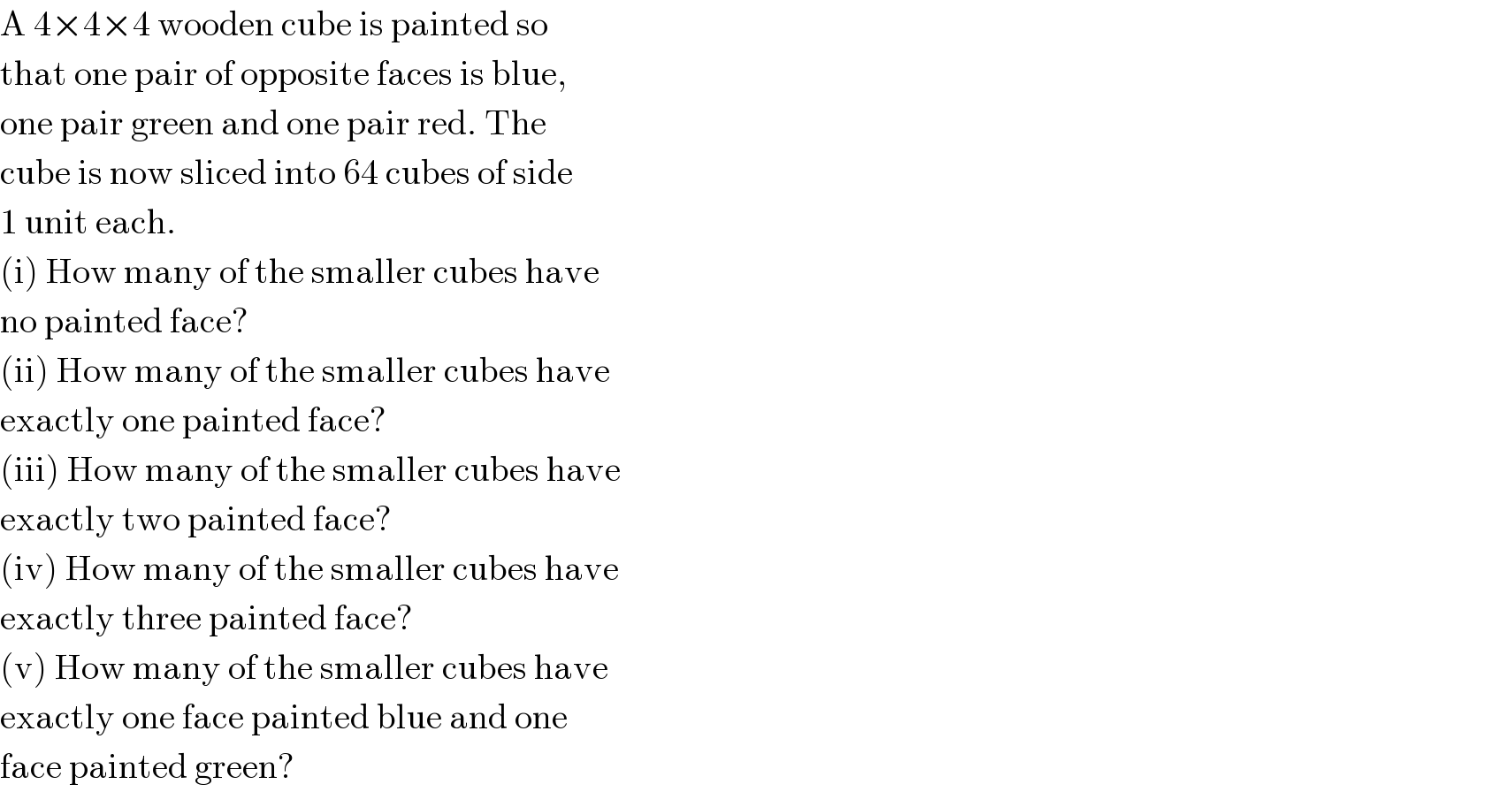Question Number 18133 by Tinkutara last updated on 15/Jul/17

$$\mathrm{A}\:\mathrm{4}×\mathrm{4}×\mathrm{4}\:\mathrm{wooden}\:\mathrm{cube}\:\mathrm{is}\:\mathrm{painted}\:\mathrm{so} \\ $$$$\mathrm{that}\:\mathrm{one}\:\mathrm{pair}\:\mathrm{of}\:\mathrm{opposite}\:\mathrm{faces}\:\mathrm{is}\:\mathrm{blue}, \\ $$$$\mathrm{one}\:\mathrm{pair}\:\mathrm{green}\:\mathrm{and}\:\mathrm{one}\:\mathrm{pair}\:\mathrm{red}.\:\mathrm{The} \\ $$$$\mathrm{cube}\:\mathrm{is}\:\mathrm{now}\:\mathrm{sliced}\:\mathrm{into}\:\mathrm{64}\:\mathrm{cubes}\:\mathrm{of}\:\mathrm{side} \\ $$$$\mathrm{1}\:\mathrm{unit}\:\mathrm{each}. \\ $$$$\left(\mathrm{i}\right)\:\mathrm{How}\:\mathrm{many}\:\mathrm{of}\:\mathrm{the}\:\mathrm{smaller}\:\mathrm{cubes}\:\mathrm{have} \\ $$$$\mathrm{no}\:\mathrm{painted}\:\mathrm{face}? \\ $$$$\left(\mathrm{ii}\right)\:\mathrm{How}\:\mathrm{many}\:\mathrm{of}\:\mathrm{the}\:\mathrm{smaller}\:\mathrm{cubes}\:\mathrm{have} \\ $$$$\mathrm{exactly}\:\mathrm{one}\:\mathrm{painted}\:\mathrm{face}? \\ $$$$\left(\mathrm{iii}\right)\:\mathrm{How}\:\mathrm{many}\:\mathrm{of}\:\mathrm{the}\:\mathrm{smaller}\:\mathrm{cubes}\:\mathrm{have} \\ $$$$\mathrm{exactly}\:\mathrm{two}\:\mathrm{painted}\:\mathrm{face}? \\ $$$$\left(\mathrm{iv}\right)\:\mathrm{How}\:\mathrm{many}\:\mathrm{of}\:\mathrm{the}\:\mathrm{smaller}\:\mathrm{cubes}\:\mathrm{have} \\ $$$$\mathrm{exactly}\:\mathrm{three}\:\mathrm{painted}\:\mathrm{face}? \\ $$$$\left(\mathrm{v}\right)\:\mathrm{How}\:\mathrm{many}\:\mathrm{of}\:\mathrm{the}\:\mathrm{smaller}\:\mathrm{cubes}\:\mathrm{have} \\ $$$$\mathrm{exactly}\:\mathrm{one}\:\mathrm{face}\:\mathrm{painted}\:\mathrm{blue}\:\mathrm{and}\:\mathrm{one} \\ $$$$\mathrm{face}\:\mathrm{painted}\:\mathrm{green}? \\ $$
Answered by sandy_suhendra last updated on 16/Jul/17

$$\left.\mathrm{1}\right)\:\left(\mathrm{4}−\mathrm{2}\right)^{\mathrm{3}} \:=\:\mathrm{8}\:\left(\mathrm{this}\:\mathrm{is}\:\mathrm{like}\:\mathrm{volume}\right) \\ $$$$\left.\mathrm{2}\right)\:\mathrm{6}\:\left(\mathrm{4}−\mathrm{2}\right)\:=\:\mathrm{12}\:\left(\mathrm{this}\:\mathrm{is}\:\mathrm{like}\:\mathrm{surface}\:\mathrm{area}\right) \\ $$$$\left.\mathrm{3}\right)\:\mathrm{12}\:\left(\mathrm{4}−\mathrm{2}\right)\:=\:\mathrm{24}\:\left(\mathrm{this}\:\mathrm{is}\:\mathrm{like}\:\mathrm{the}\:\mathrm{sum}\:\mathrm{of}\:\mathrm{edges}\right) \\ $$$$\left.\mathrm{4}\right)\:\mathrm{8}\:\left(\mathrm{vertices}\right) \\ $$$$\left.\mathrm{5}\right)\:\mathrm{4}\:\left(\mathrm{4}−\mathrm{2}\right)\:=\:\mathrm{8} \\ $$
Commented by Tinkutara last updated on 16/Jul/17

$$\mathrm{Thanks}\:\mathrm{Sir}! \\ $$
